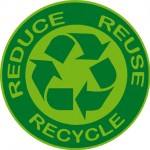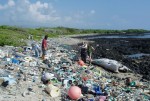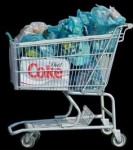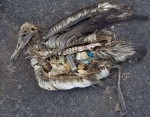 How many times have we heard the phrase,”Reduce, Reuse, Recycle?” Since the inauguration of the Reduce, Reuse, Recycle or 3Rs campaign in the mid 80s the green movement to better our planet has become a global effort. There are now receptacles for recycling glass, plastic, aluminum, and paper in office buildings, schools, and shopping centers. Most cities have a curbside pick-up service for all recyclables. In addition, you cannot step foot inside a store without seeing reusable bags at the checkout. So if it is easier than ever to recycle why aren’t we all doing our part? Not enough time? We don’t think it actually matters? We don’t really care?
How many times have we heard the phrase,”Reduce, Reuse, Recycle?” Since the inauguration of the Reduce, Reuse, Recycle or 3Rs campaign in the mid 80s the green movement to better our planet has become a global effort. There are now receptacles for recycling glass, plastic, aluminum, and paper in office buildings, schools, and shopping centers. Most cities have a curbside pick-up service for all recyclables. In addition, you cannot step foot inside a store without seeing reusable bags at the checkout. So if it is easier than ever to recycle why aren’t we all doing our part? Not enough time? We don’t think it actually matters? We don’t really care?
To me, following the 3Rs philosophy seems to be so simple; we reduce what we use, we reuse items after their first use, and we recycle those products that can no longer be used. Unfortunately, the fast paced life that we live gives us little time to be fully aware of our actions, or lack thereof. Case in point is our morning ritual of coffee or tea. The average office worker in the United States throws away ~500 disposable cups per year; this is one reason that I have sworn off to-go products from coffee houses. It is quite the site on a college campus to see the garbage cans running over by 10:00 am with the discards of an early morning caffeine fix from Starbucks. By simply using a refillable mug we not only reduce the waste we generate, but at some cafes are given a discount for using our own cup. However, it’s not just about paper cups; think of all the things you use once and then throw away. In this fantastic digital age, why are we still buying and sending greeting cards? On average, more than 2.6 billion holiday cards i.e., Christmas, Easter, Halloween, Hanukkah, and Thanksgiving are sold annually. Furthermore, think about the wrapping paper and ribbon waste that is accumulated throughout the year for gift-giving occasions. What are some alternatives?
actions, or lack thereof. Case in point is our morning ritual of coffee or tea. The average office worker in the United States throws away ~500 disposable cups per year; this is one reason that I have sworn off to-go products from coffee houses. It is quite the site on a college campus to see the garbage cans running over by 10:00 am with the discards of an early morning caffeine fix from Starbucks. By simply using a refillable mug we not only reduce the waste we generate, but at some cafes are given a discount for using our own cup. However, it’s not just about paper cups; think of all the things you use once and then throw away. In this fantastic digital age, why are we still buying and sending greeting cards? On average, more than 2.6 billion holiday cards i.e., Christmas, Easter, Halloween, Hanukkah, and Thanksgiving are sold annually. Furthermore, think about the wrapping paper and ribbon waste that is accumulated throughout the year for gift-giving occasions. What are some alternatives?
 Growing up as a kid there was never a time when my mum did not reuse butter bowels or jam jars to hold leftovers from dinner. We used paper egg cartons as mini flower pots for seed planting and turned plastic twist ties into Christmas ornaments that still adorn the family tree. Twenty years ago we did not have curbside trash pickup, so it was imperative to reduce our waste as much as possible; this would also mean less waste you would have to cart to the dumpsite in the family car. The United States is one of the world’s largest producers of garbage. On average, every American produces 730 kg (1,609 lbs) of trash every year. Comparably, in Australia 606 kg of trash per person is generated a year, 574 kg per person in England and 555 kg on average in Germany. So how much of this trash isrecycled? Of the 70-80% of the trash that could be recycled, less than 25% actually is. According to the Environmental Protection Agency, recycling just one ton of paper would: save enough energy to power the average American home for six months; save 7,000 gallons of water; save 3.3 cubic yards of landfill space; save approximately 20 trees; and reduce greenhouse gas emissions by one metric ton of carbon equivalent. If you consider that the world consumes roughly 300 million tons of paper every year, the need to recycle is monumental.
Growing up as a kid there was never a time when my mum did not reuse butter bowels or jam jars to hold leftovers from dinner. We used paper egg cartons as mini flower pots for seed planting and turned plastic twist ties into Christmas ornaments that still adorn the family tree. Twenty years ago we did not have curbside trash pickup, so it was imperative to reduce our waste as much as possible; this would also mean less waste you would have to cart to the dumpsite in the family car. The United States is one of the world’s largest producers of garbage. On average, every American produces 730 kg (1,609 lbs) of trash every year. Comparably, in Australia 606 kg of trash per person is generated a year, 574 kg per person in England and 555 kg on average in Germany. So how much of this trash isrecycled? Of the 70-80% of the trash that could be recycled, less than 25% actually is. According to the Environmental Protection Agency, recycling just one ton of paper would: save enough energy to power the average American home for six months; save 7,000 gallons of water; save 3.3 cubic yards of landfill space; save approximately 20 trees; and reduce greenhouse gas emissions by one metric ton of carbon equivalent. If you consider that the world consumes roughly 300 million tons of paper every year, the need to recycle is monumental.
 I highly commend stores for encouraging shoppers to use reusable shopping bags. Every year, Americans alone use over 1 billion plastic shopping bags which in turn results in 300,000 tons of garbage in our landfills. Let me remind you that plastic is a petroleum product. Recently, a few
I highly commend stores for encouraging shoppers to use reusable shopping bags. Every year, Americans alone use over 1 billion plastic shopping bags which in turn results in 300,000 tons of garbage in our landfills. Let me remind you that plastic is a petroleum product. Recently, a few grocery storechains have been charging patrons $0.05 to 0.10 US per bag with an additional warning that in a period of time plastic bags be will no longer be available. Plastic bag waste seems to have taken over even the most remote and fragile of ecosystems. Plastic in general has littered our oceans and forests. Every year, millions of animals die from ingestion of plastic or asphyxiation from plastic bags. The dead bodies of Albatross chicks can be commonly found on the shores of their home range filled with plastic remnants.
grocery storechains have been charging patrons $0.05 to 0.10 US per bag with an additional warning that in a period of time plastic bags be will no longer be available. Plastic bag waste seems to have taken over even the most remote and fragile of ecosystems. Plastic in general has littered our oceans and forests. Every year, millions of animals die from ingestion of plastic or asphyxiation from plastic bags. The dead bodies of Albatross chicks can be commonly found on the shores of their home range filled with plastic remnants.
 Fishing nets recklessly discarded at sea are responsible for drowning thousands of marine mammals every year. A good friend recalls a story from when she lived in Hawaii. Surfers and beach combers would collect nets, rope, etc., that would wash up on the beach daily. All collected items were taken to a local surf shop parking lot to be put on display to alert passersby. Within just eight months the pile of collected rubbish was over ten feet tall and weighed more than a ton. That amount of trash is incredible when you think that it was collected from only one beach for such a short amount of time.
Fishing nets recklessly discarded at sea are responsible for drowning thousands of marine mammals every year. A good friend recalls a story from when she lived in Hawaii. Surfers and beach combers would collect nets, rope, etc., that would wash up on the beach daily. All collected items were taken to a local surf shop parking lot to be put on display to alert passersby. Within just eight months the pile of collected rubbish was over ten feet tall and weighed more than a ton. That amount of trash is incredible when you think that it was collected from only one beach for such a short amount of time.
I could sit for days and list statistics regarding the waste we generate, where it ends up and what it is doing to our environment, but I think we all understand. The most important point is that, to work, the 3R philosophy has to be practiced as a whole. Just because we recycle does not entitle us to overuse those same products. Once again awareness is key in understand the consequences to our actions. We can and must do better.
understand. The most important point is that, to work, the 3R philosophy has to be practiced as a whole. Just because we recycle does not entitle us to overuse those same products. Once again awareness is key in understand the consequences to our actions. We can and must do better.